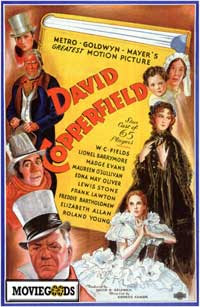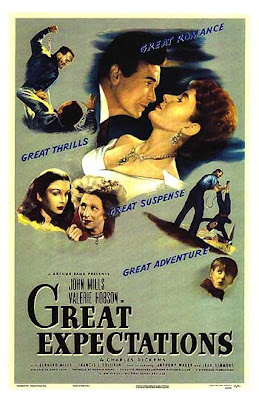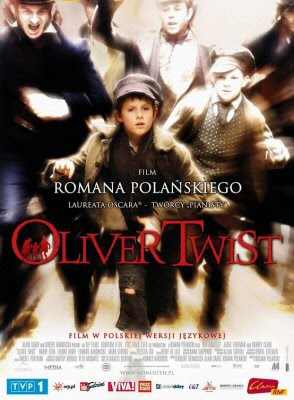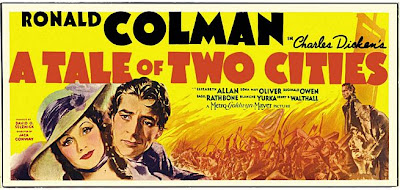 Dickens has been by far the most filmed of English novelists, with something like one hundred versions in the silent era alone, and numerous further adaptations for both film and television, continuing to the present day. The earliest films could cope only with well-known incidents or brief character sketches from the books; the sheer length of the major novels has always proved a serious stumbling block. It was natural, then, that the first attempts at full-length treatment would be with shorter works such as A Christmas Carol, A Tale of Two Cities, or Oliver Twist, all filmed several times each before 1920.
Dickens has been by far the most filmed of English novelists, with something like one hundred versions in the silent era alone, and numerous further adaptations for both film and television, continuing to the present day. The earliest films could cope only with well-known incidents or brief character sketches from the books; the sheer length of the major novels has always proved a serious stumbling block. It was natural, then, that the first attempts at full-length treatment would be with shorter works such as A Christmas Carol, A Tale of Two Cities, or Oliver Twist, all filmed several times each before 1920.
Though Dickens has often been called the most cinematic of novelists, his books are far from easy to film satisfactorily. The mixture of realism and symbolism, especially in the later novels, the often larger-than-life or grotesque characters, the first-person narration of some books, the pervasive authorial narrative tone and commentary of others, the sheer scope and variety of characters, incidents and settings, and the insistent social and moral analysis of the later works in particular, all provide formidable barriers that have rarely been totally overcome. All of the thirteen novels have been filmed at one time or another, but the choice has consistently been skewed toward the more realistic,
usually early, works, or to those that contain the best-known characters—where the filmmaker is often assisted by the illustrations of George Cruikshank (1792–1878) and "Phiz" (Hablot Knight Browne) (1815–1882), which accompanied the original publications. The complex, densely structured, darker books like Bleak House, Little Dorrit, and Our Mutual Friend have generally met with far less favor.
Though few, if any, of the film adaptations have coped with all the challenges presented by the books, there have been several at least partial successes. David Copperfield, A Tale of Two Cities, A Christmas Carol, Oliver Twist, and Great Expectations have been the most frequently filmed, with, in almost every case, the focus being fixed on character and plot rather than the social criticism that made Dickens such an important figure in his time. The most notable of these include the MGM David Copperfield of 1935, sensitively directed by George Cukor (1899–1983) and with inspired casting that included W. C. Fields (1880–1946) as Micawber, and the same studio's A Tale of Two Cities (also 1935), with a memorable performance by Ronald Colman (1891–1958) as Sydney Carton. These two films still stand as the best adaptations of these books. David Lean's (1908–1991) Great Expectations (1946) and Oliver Twist (1948) are generally considered the classic treatments of these works and the definitive A Christmas Carol is widely acknowledged to be the 1951 Scrooge, starring Alastair Sim (1900–1976). Though Lean's Great Expectations is often considered the finest of Dickens adaptations, it can be argued that his version of Oliver Twist succeeds better in capturing the many dimensions of Dickens's work—the realistic, the grotesque, the comical, the social comment, the sentimental, the symbolic, the fascination with violence—presented in imagery that creates London both as a real city and a symbolic underworld. It does all this much more successfully than Polanski's disappointing treatment (2005). Other interesting versions of less frequently filmed works include The Mystery of Edwin Drood (Stuart Walker, 1935), Nicholas Nickleby (Alberto Cavalcanti, 1947), and the ambitious but flawed two-part Little Dorrit (Christine Edzard, 1988). The well-cast and intelligently reworked Nicholas Nickleby (Douglas McGrath, 2002) unfortunately met with scant interest at the box office. In recent years the most impressive adaptations have come from British television, where the serial format of three to four hours or more can allow a fuller and more leisurely treatment of the texts. Some of the best of these have been Granada Television's Hard Times (1977) and the BBC's Bleak House (1985), Martin Chuzzlewit (1994), and Our Mutual Friend (1998)—all of them books largely neglected by the cinema.
and Oliver Twist (1948) are generally considered the classic treatments of these works and the definitive A Christmas Carol is widely acknowledged to be the 1951 Scrooge, starring Alastair Sim (1900–1976). Though Lean's Great Expectations is often considered the finest of Dickens adaptations, it can be argued that his version of Oliver Twist succeeds better in capturing the many dimensions of Dickens's work—the realistic, the grotesque, the comical, the social comment, the sentimental, the symbolic, the fascination with violence—presented in imagery that creates London both as a real city and a symbolic underworld. It does all this much more successfully than Polanski's disappointing treatment (2005). Other interesting versions of less frequently filmed works include The Mystery of Edwin Drood (Stuart Walker, 1935), Nicholas Nickleby (Alberto Cavalcanti, 1947), and the ambitious but flawed two-part Little Dorrit (Christine Edzard, 1988). The well-cast and intelligently reworked Nicholas Nickleby (Douglas McGrath, 2002) unfortunately met with scant interest at the box office. In recent years the most impressive adaptations have come from British television, where the serial format of three to four hours or more can allow a fuller and more leisurely treatment of the texts. Some of the best of these have been Granada Television's Hard Times (1977) and the BBC's Bleak House (1985), Martin Chuzzlewit (1994), and Our Mutual Friend (1998)—all of them books largely neglected by the cinema.
Although all the films mentioned are set in the Victorian period, there have been some attempts at updating them. Rich Man's Folly (1931), a truncated and unsatisfactory version of Dombey and Son, is set at the time of filming, as is a misbegotten Great Expectations (Alfonso Cuarón, 1998), which succeeds in getting almost everything about the novel wrong. By far the best updating is the Portuguese director Joâo Botelho's (b. 1949) Tempos difíceis (Hard Times, 1989), where Dickens's assault on the capitalist mentality remains as relevant today as it was during his lifetime. And, although most of the films based on Dickens's works have come from the English-speaking world, there have also been German, French, Italian, Danish, Russian, and Hungarian treatments, mostly in the silent period.

No comments:
Post a Comment